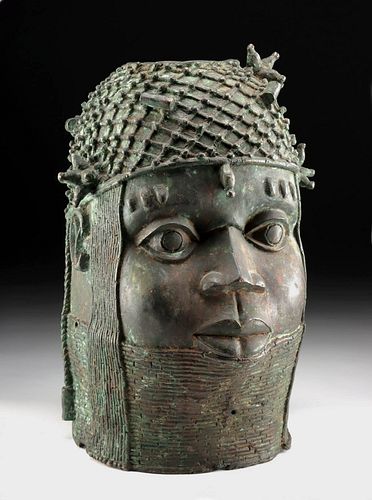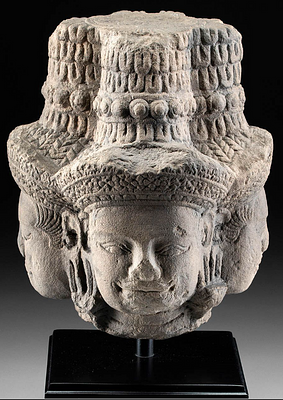Superb 17th C. African Benin Bronze Oba Ruler Head
Lot 125b
About Seller
Artemis Fine Arts
686 S Taylor Ave, Ste 106
Louisville, CO 80027
United States
Selling antiquities, ancient and ethnographic art online since 1993, Artemis Gallery specializes in Classical Antiquities (Egyptian, Greek, Roman, Near Eastern), Asian, Pre-Columbian, African / Tribal / Oceanographic art. Our extensive inventory includes pottery, stone, metal, wood, glass and textil...Read more
Categories
Estimate:
$28,000 - $42,000
Absentee vs Live bid
Two ways to bid:
- Leave a max absentee bid and the platform will bid on your behalf up to your maximum bid during the live auction.
- Bid live during the auction and your bids will be submitted real-time to the auctioneer.
Bid Increments
| Price | Bid Increment |
|---|---|
| $0 | $25 |
| $300 | $50 |
| $1,000 | $100 |
| $2,000 | $250 |
| $5,000 | $500 |
| $10,000 | $1,000 |
| $20,000 | $2,500 |
| $50,000 | $5,000 |
| $100,000 | $10,000 |
| $200,000 | $20,000 |
About Auction
By Artemis Fine Arts
Jun 29, 2023
Set Reminder
2023-06-29 10:00:00
2023-06-29 10:00:00
America/New_York
Bidsquare
Bidsquare : Exceptional Antiquities, Ethnographic and Fine Art
https://www.bidsquare.com/auctions/artemis-gallery/exceptional-antiquities-ethnographic-and-fine-art-13031
Artemis Fine Arts info@artemisgallery.com
Artemis Fine Arts info@artemisgallery.com
- Lot Description
Africa, Nigeria, Edo, Court of Benin, ca. 17th to 19th century CE. An impressive brass (bronze) cast head depicting an Oba (king of Benin) wearing a net-like coral cap and a high coral beaded choker. The coral headdress and choker are significant royal court attributes that identify this as the head of an Oba. The opening at the top of the head was created for sculpted elephant tusk that was carved to depict the many accomplishments of the king - a personal shrine. A piece like this would have been commissioned by a newly enthroned oba to stand on an altar and commemorate a previous oba, most likely his father. The oba of Benin rules via divine right and serves as the being through which his deified royal ancestors protect and invigorate the kingdom. In Benin, the head is a prominent symbol representing an individual's ability to progress successfully through life and develop himself so that he may one day be a revered and helpful ancestor. Size: 10" Diameter x 14.5" H (25.4 cm x 36.8 cm)
Though the metal composition of this piece is consistent with that of brass, examples like this have traditionally been referred to as bronzes. Joseph Nevadomsky and Natalie Lawson explain in "The Dating Game: The Scientific Analysis of Benin Copper-Alloy Art-From TL to 21Pb" that "That problem is complex. Keep the following in mind. First is that Benin cast artifacts are typically called "Benin bronzes" but they are now referred to as brass; the composition of a sample of objects at the National Museum of African Art, Smithsonian, Washington, D.C., ranged 'from 64 to 94% copper, 0 to 7% tin, 1 to 17% lead, and 0 to 16% zinc' as well as 'small quantities of arsenic, silver, antimony, and nickel' with iron at 0.4 to 5% Schrenk [1] Copper alloy is the correct designation, but Benin 'bronze' became equated with royal art from Europe early on and stuck for a century at least while brass is now commonly used by art historians." (Joseph Nevadomsky, Natalie Lawson. The Dating Game: The Scientific Analysis of Benin Copper-Alloy Art-From TL to 21Pb. Open Access J Arch & Anthropol. 1(5): 2019. OAJAA.MS.ID.000525.)
This piece has been tested for the presence or absence of particular elements via XRF elemental analysis. A full XRF report identifying the quantity of each element present in the sample will accompany purchase. The report certifies that the element composition is consistent with antiquity and will be included with the purchase.
Similar examples may be found in the British Museum, published in Leon Underwood's "Bronzes of West Africa" - figure 31 - (London, 1949) and William B. FAGG: Bildwerke aus Nigeria, Munchen 1963, S. 45; the Staatliche Museen zu Berlin, Ethnologisches Museum published in Felix von LUSCHAN: Die Altertumer von Benin, Band 1-3, Berlin 1919, Tafel 59; The Perls Collection in The Metropolitan Museum of Art, New York published in Kate EZRA: Royal Art of Benin. The Perls Collection in The Metropolitan Museum of Art, New York 1992, S. 36; and several other museum collections.
This item is heavy/oversized and will require 3rd party shipping. Please inquire about shipping cost prior to bidding.
Provenance: private Danbury, New Hampshire, USA collection; ex-Brimfield, Massachusetts collection, USA; ex-private collection, Malden, Massachusetts, USA, prior to 2000
All items legal to buy/sell under U.S. Statute covering cultural patrimony Code 2600, CHAPTER 14, and are guaranteed to be as described or your money back.
A Certificate of Authenticity will accompany all winning bids.
We ship worldwide and handle all shipping in-house for your convenience.
#177203Surface abrasions and wear commensurate with age. Green oxidation and patina and weathering. Intact without repairs, excellent and choice. XRF tested and consistent with Benin composition, and will come with XRF report.Condition
- Shipping Info
-
All shipping is handled in-house for your convenience. Your invoice from Artemis Gallery will include shipping calculation instructions. If in doubt, please inquire BEFORE bidding for estimated shipping costs for individual items.
-
- Buyer's Premium



 EUR
EUR CAD
CAD AUD
AUD GBP
GBP MXN
MXN HKD
HKD CNY
CNY MYR
MYR SEK
SEK SGD
SGD CHF
CHF THB
THB
















